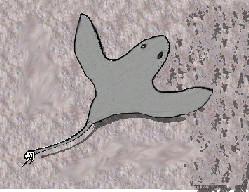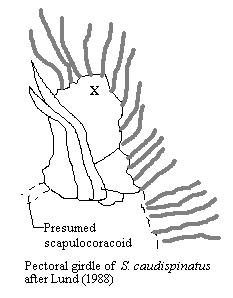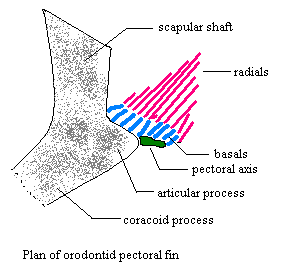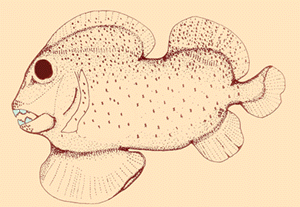 Squatinactida:
Squatinactida:| Chondrichthyes | ||
| The Vertebrates | Chondrichthyes |
| Vertebrates Home | Vertebrate | Vertebrate |
|
Abbreviated Dendrogram
Thelodonti
├─Placodermi
│
└─Eugnathostomata
├─Chondrichthyes
│ ├─Squatinactida
│ ├─Orodontida
│ ├─┬─Eugeneodontida
│ │ └─Petalodontiformes
│ └─Chondrichthyes (Crown)
│ ├─┬─Cladoselachida
│ │ └─Symmoriida
│ │ ├─Symmoriidae
│ │ └─Holocephali
│ └─Elasmobranchii
│ ├─Xenacanthida
│ └─Ctenacanthiformes
│ ├─Ctenacanthidae
│ └─Euselachii
│ ├─Hybodontiformes
│ └─┬─Synechodontiformes
│ └─Neoselachii
└─Teleostomi
|
Contents
Overview |
Range: from the Llandovery
Phylogeny: Eugnathostomata : Teleostomi + * : Squatinactida + Orodontida + (Eugeneodontida + Petalodontiformes) + Chondrichthyes (Crown).
Characters: Cartilaginous fish with prismatic calcified cartilage (layer of minute platelets of CaPO4); paired nasal cavities; inner ear with three semicircular canals; 3-cusped teeth with little bone (dentine + enameloid only) or root; teeth of modified placoid scales; visceral arches located deeply next to the pharynx; five to seven pairs of gills with separate and exposed gill slits & without operculum; swim bladder and lung absent; heterocercal caudal fin; digestive system with J-shaped stomach; intestine short but surface area increased by a spiral valveskin with placoid scales and mucous glands; electroreceptive system well developed; Separate sexes; oviparous, ovoviviparous or viviparous; internal fertilisation and direct development.
Introduction to the Chondrichthyes; Whales release; Animal Diversity Web: Class Chondrichthyes ADW: individual species accounts); OceanLink Answers to Chondrichthyes Questions; Fishes - Class Chondrichthyes; Cartilaginous fishes (Chondrichthyes) - MavicaNET a good collection of sites); Chondrichthyes - Knorpelfische; Chondrichthyes Mikko's Phylogeny); Radiation of the Chondrichthyes. Caution: there are many really awful sites on this taxon.
ATW040115.
Range: upC of NAm.
Phylogeny: Chondrichthyes : Orodontida + (Eugeneodontida + Petalodontiformes) + Chondrichthyes (Crown) + *.
Characters: Skate-like body to 1m long, with expanded pectoral fin. Large head; mouth terminal; large jaws; long, cladodont teeth with sharp cusps; pectoral fin anterolaterally expanded, with numerous radials articulating directly on a base; unusual pectoral fin girdle; moderately long vertebral column; vertebral spines near post end; no known pelvic fin; post-cephalic structure otherwise unknown; a few placoid scales.
Discussion: The squatinactids are another orphan lineage of Paleozoic proto-sharks. Squatinactis, the only known genus in this taxon, is unique in combining a ray-like expanded dorsal and spines with unusually long sharp orodont teeth. Squatinactus cadispinatus was originally described by Lund and Zangerl in 1974 from a remarkably strange Bear Creek fossil which has been figured in Zangerl 1981), Carroll 1988) and elsewhere. Subsequently, additional material was described from the same location by Lund 1988). However, Lund's Bear Creek web site (former site) at one time featured a beautiful specimen called Squatinactis montanus which appears rather different in proportions, although much the same in structure. It is not clear from context whether this is a new (and perhaps undescribed) species or a different, renamed reconstruction of the older material.
In any case, Squatinactis seems fairly convincing as a Torpedo-style hunter, which is the genesis of the crude reconstruction figured in these Notes. The torpediniforms are largely ambush predators who lurk on or in bottom sediments. When they encounter suitable prey, they "jump" on their expanded dorsal fins, sucking the victim in under the mantle, which is then folded over the prospective lunch. Unlike modern rays, squatinactids presumably lacked electric cooking, which may well have dictated a somewhat different design. This hunting strategy makes sense out of what might otherwise seem a bizarre architecture. The anteriorly directed dorsals make little hydrodynamic sense for swimming. However, if the objective is to surge upward and forward over a slow-moving Paleozoic fish, in a single movement, Squatinactis is very well designed.
 The unusual pectoral girdle described by Lund (1988) reinforces this speculation see figure). If one supposes that the three, otherwise pointless, elements attached to the scapulocoracoid were designed to slide over each other, the whole affair operates as the equivalent of a ball-in-socket joint. In that case, contraction of the pectoral mscles would translate the force of flexion into a vertical force against the bottom, roughly at the point labelled "X", propelling the body up and forward.
The unusual pectoral girdle described by Lund (1988) reinforces this speculation see figure). If one supposes that the three, otherwise pointless, elements attached to the scapulocoracoid were designed to slide over each other, the whole affair operates as the equivalent of a ball-in-socket joint. In that case, contraction of the pectoral mscles would translate the force of flexion into a vertical force against the bottom, roughly at the point labelled "X", propelling the body up and forward.
In this hunting strategy, a substantial tail is only an encumberance. Modern rays use the tail primarily for a quick, very precise turn in order to face their prey as they are "jumping." Following the speculation in the original literature, Squatinactis has been reconstructed here with tail spines, like a sting ray. However, an equally sensible interpretation is to reconstruct the caudal spines as supporting a small, rigid caudal fin. At the end of the long lever arm provided by the whip-like tail in Squatinactis, even a very small fin, if adequately stiffened, would provide the same quick turning ability which torpediniforms acheive today with their shorter, but heavier, equipment.
References: Lund (1988); Zangerl (1981). 011016.
 Orodontida = Orodontiformes?): Orodus.
Orodontida = Orodontiformes?): Orodus.
Range: upD-upC.
Phylogeny: Chondrichthyes : Squatinactida + (Eugeneodontida + Petalodontiformes) + Chondrichthyes Crown) + *.
Characters: Large (up to
4m & possible much larger) elongate, even eel-like; head broad and blunt; reduced fins; braincase poorly calcified; palatoquadrate poorly defined; Meckellian cartilage (lower jaw) short and dorso-ventrally expanded; pavement dentition, including symphisial tooth families; teeth broad, ridged surface, no cusps; vertebral column from series of paired neural "pieces" (?); hemapophyses present in tail area; fins small to tiny; 1 dorsal fin (possibly 2 in an undescribed Bear Gulch form per Lund (1990)), no anal fin; no fin spines per Zangerl (1981) and other sources, but Lund (1990) disagrees); scapular shaft ends with anterior-facing point; coracoid short; pronounced articular process for attachment of fin base; pectoral fin has a proximo-distal axis element to which about 1/2 of basal rods attach, remainder attaching directly to articular process; distal fin elements are single set of undivided radials; pelvic fins present but small and poorly known;  ventral lobe of caudal fin from undivided radials, dorsal lobe unknown; covered with heavy armor of cyclomorial (?) composite scales made up of modified lepidomoria; most complex scales are dorsal, with progressively simpler denticles ventrally and posteriorly; marine.
ventral lobe of caudal fin from undivided radials, dorsal lobe unknown; covered with heavy armor of cyclomorial (?) composite scales made up of modified lepidomoria; most complex scales are dorsal, with progressively simpler denticles ventrally and posteriorly; marine.
Sharks Teeth in the Hunterian Museum (see entry for Orodus).
Note: The presence of prismatic cartilage has been questioned by Zangerl (1981) which would suggest that orodonts are basal to Chondrichthyes. Similarly, he is uncertain whether the palatoquadrate is poorly preserved, absent, or fused to the neurocranium. Lund (1990) asserts that the orodontids were holostilic and unites them with the Iniopterygii, petalodonts, and other groups in a large taxon, Paraselachimorpha. 000608.
Eugeneodontida: Helicoprion.
lw?C-lwT.
Chondrichthyes :: Petalodontiformes + *.
Median tooth whorl on symphysis of lower jaw – fit in cavity between two similar series in upper jaw; function unclear. Single dorsal without spines; pectorals supported by long radials (1-2 segments) articulating on girdle; no anal or pelvic fins (or unknown?). Diverse body shapes, poorly known; usu long rostrum. Some have lost palatoquadrate or fused with cranium.
Links: link; link; link; Heliocoprion sp.. 991010.
 Petalodontiformes: Ctenoptychius, Belantsea, Fissodus, Janassa, Netsepoye, Paracymatodus
Petalodontiformes: Ctenoptychius, Belantsea, Fissodus, Janassa, Netsepoye, Paracymatodus
Chondrichthyes :: Eugeneodontida + *.
Strikingly skate-like in structure, but not necessarily appearance; armor around mouth; pavement teeth; peculiar, bulbous body form; .
Links: Petalodontiformes; Untitled; Untitled; The American Elasmobranch Society Hompage; Chondrichthyans from the Pennsylvanian Minturn Formation of ...; Condrichthyes Page; ?·??????????; Sharks Teeth in the Hunterian Museum; Poecilodus jonesii - Japanese: teeth. Short essay questioning monophyly?); Fish of the Bear Gulch Prof. Lund's site is back at a new address and is once more Best on the Web); Petalodus sp - Pennsylvanian Shark Tooth - Lake Neosho Shale huge images of teeth -- unfortunately not very typical, but note internal structure of broken tooth).
Image: Belantsea montana life reconstruction by Prof. Richard Lund. Reproduced by permission. ATW031206.
checked ATW060126